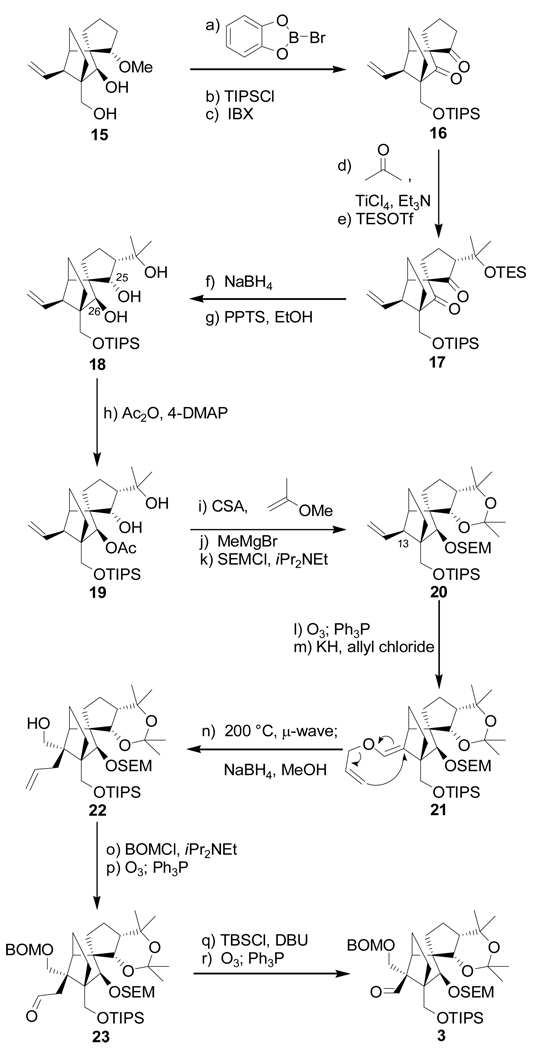Scheme 2.
Construction of aldehyde 3. Reagents and conditions: (a) B-Br-catecholborane (3.5 equiv), CH2Cl2, 25 → 50 °C, 3 h; (b) TIPSCl (1.5 equiv), imid (6.0 equiv), DMF, 24 h, 70 % for two steps; (c) IBX (4.0 equiv), DMSO, 50 °C, 4 h, 90 %; (d) TiCl4 (1.0 M in CH2Cl2, 1.2 equiv), Et3N (3.0 equiv), CH2Cl2, −78 → −30 °C, 30 min; then acetone, −92 °C, 12 h (9:1 dr); (e) TESOTf (3.0 equiv), 2,6-lut. (5.0 equiv), −78 → −40 °C, 1 h, 81 % for the two steps; (f) NaBH4 (20 equiv), THF:MeOH (1:1), −10 → 25 °C, 5 h; (g) PPTS (0.2 equiv), EtOH, 25 °C, 2 h, 85 % for two steps; (h) Ac2O (30 equiv), 4-DMAP (0.1 equiv), Et3N (40 equiv), CH2Cl2, 25 °C, 18 h, 79 %; (i) 2-methoxypropene (20 equiv), CSA (1.0 equiv), CH2Cl2, −78 → −30 °C, 3 h, 82 %; (j) CH3MgBr (50 equiv), PhMe, 50 °C, 8 h, 94 %; (k) SEMCl (10 equiv), iPr2NEt (30 equiv), TBAI (1.0 equiv), CH2Cl2, 50 °C, 48 h, 96 %; (l) O3, py (1.0 equiv), CH2Cl2:MeOH (1:1), −78 °C; then Ph3P (5.0 equiv), −78 → 25 °C, 1 h, 96 %; (m) KH (10 equiv), allyl chloride (20 equiv), HMPA (5.0 equiv), DME, −10 → 25 °C, 3 h, 92 %; (n) iPr2NEt (1.0 equiv), 1,2-dichlorobenzene, 200 °C (µ-wave), 20 min; then NaBH4 (20 equiv), MeOH, 1 h, 25 °C, 88 % for two steps; (o) BOMCl (6.0 equiv), iPr2NEt (15 equiv), CH2Cl2, 50 °C 12 h; (p) O3, py (1.0 equiv), CH2Cl2:MeOH (1:1), −78 °C; then Ph3P (5.0 equiv), −78 → 25 °C, 1 h, 85 % for two steps; (q) TBSCl (10 equiv), DBU (20 equiv), CH2Cl2, 25 °C, 36 h; (r) O3, py (1.0 equiv), CH2Cl2:MeOH (1:1), −78 °C; then Ph3P (5.0 equiv), −78 → 25 °C, 1 h, 97 % for two steps. TIPS = triisopropylsilyl, TES = triethylsilyl, 2,6-lut. = 2,6-dimethylpyridine, PPTS = pyrdinium p-toluene-sulfonate, CSA = camphorsufonic acid, HMPA = hexamethylphosphoramide, DBU = 1,8-diazoicyclo[5.4.0]undec-7-ene.

